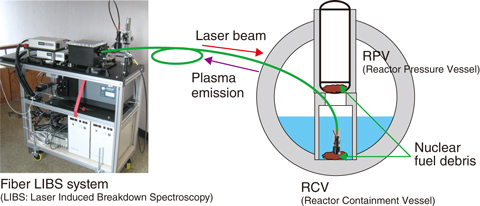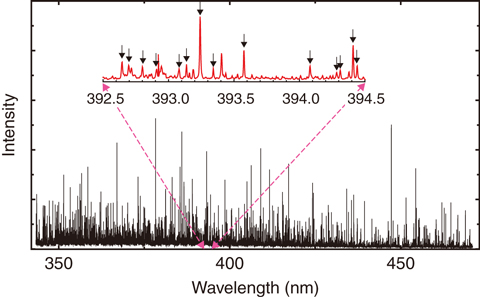
Fig.1-7 Image of the fiber LIBS system

Fig.1-8 U spectrum measured by the LIBS
To safely retrieve, process, and dispose of the nuclear-fuel debris from the accident at the TEPCO’s Fukushima Daiichi NPS, it is very important to know state of the debris itself. One piece of information is the elementary composition of the debris. However, in an extremely high radiation environment, the nuclear reactor containment vessel (RCV) cannot be approached, electronic equipment cannot be employed, and the debris cannot be analyzed in situ.
Therefore, we are developing a fiber LIBS system (Fig.1-7). This system, which uses a laser and spectrometer, is set up in a low-radiation environment. The laser beam delivered through the fiber is focused onto the surface of the debris in the reactor vessel by a focusing probe. The plasma emission generated by laser irradiation is collected into the same optical fiber, delivered to the spectrometer, and measured as spectra. These spectra are analyzed and information concerning the elementary composition of the debris is evaluated. In this fashion, the radiation exposure to workers and electronic equipment is avoided.
Fuel debris is mainly composed of nuclear fuel (uranium (U)and plutonium (Pu)), actinides, fission products, and cladding tubes (zirconium (Zr)). Concrete (calcium), stainless steel (iron, nickel, and chrome) in the structural materials, and the like may also be included in debris. To distinguish nuclear fuel materials, such as U, from the other elements, detailed spectral data for these materials must be collected.
For this reason, using the LIBS, the U spectrum in the 350–470 nm region (Fig.1-8) was measured and the relative spectral intensities and absolute wavelengths were calibrated. For elemental composition analysis of these results, the 247 atomic lines and 294 ion lines of U were assigned and selected as useful.
To contribute to safe retrieval, processing, and disposal of nuclear-fuel debris, it is necessary to compile reliable spectral databases of U, Pu, Zr, and the other elements of the core-structure materials and the like.
The present study contains part of the result of the “Development of laser remote analysis for next generation nuclear fuel and applied study by MOX sample” project entrusted to the JAEA by the Ministry of Education, Culture, Sports, Science and Technology of Japan (MEXT).